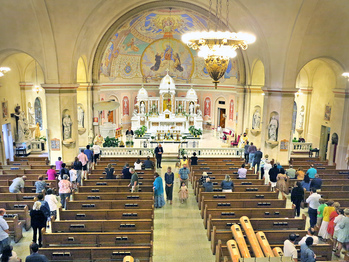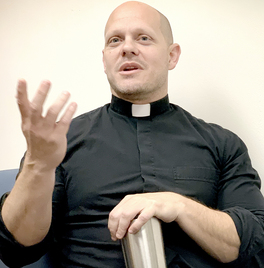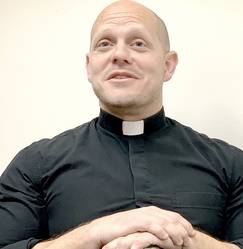
A platform that encourages healthy conversation, spiritual support, growth and fellowship

NOLACatholic Parenting Podcast
A natural progression of our weekly column in the Clarion Herald and blog

The best in Catholic news and inspiration - wherever you are!
How to safely welcome Catholics back to Mass
-

Nearly 17 months after the coronavirus pandemic prompted Archbishop Gregory Aymond to dispense Catholics from their obligation to attend Mass for fear of contracting or spreading the disease, the Archdiocese of New Orleans will restore the Mass obligation beginning the weekend of June 5-6 (Corpus Christi Sunday).
How can parishes in the archdiocese safely welcome back parishioners? What are some of the safety guidelines in place? What does this mean for the practice of our faith?
Father Nile Gross, director of the archdiocesan Office of Worship, offers his insights.
During the pandemic, did you receive a lot of calls from pastors and parishioners about how to handle safety concerns related to the celebration of Mass?
 We had numerous calls. Early on, it was from pastors asking how to handle certain situations and how they might be creative because public Masses were pretty much prohibited by COVID restrictions. In the very beginning, there were questions like, “Can we have drive-thru Communion lines?” as pastors tried to get creative with ways to provide the sacraments to their people. Once it became possible to reopen churches with a limited percentage of parishioners, the questions from the pastors started to decrease as they became more comfortable with the new norms: no holy water fonts, masks, social distancing, those types of things. Some parishes used online registration or sign-ups to limit the number of parishioners in attendance. It was all very creative and well handled, although not easy as we greatly disliked restricting the people from coming to liturgies to encounter God. Pastors used good judgment; they weren’t policing this strongly because they weren’t going to exclude you from the Mass if you didn’t register, but it was at least a way of trying to balance and limit the numbers. Other parishes added Masses so more people had opportunities to attend. There was obviously no obligation to attend Mass, but the archbishop let people know they could attend a weekday Mass so they could still engage with their faith, receive the Eucharist, join that eucharistic assembly and worship God. The archbishop always worked with civil authorities on the safe way of doing things.
We had numerous calls. Early on, it was from pastors asking how to handle certain situations and how they might be creative because public Masses were pretty much prohibited by COVID restrictions. In the very beginning, there were questions like, “Can we have drive-thru Communion lines?” as pastors tried to get creative with ways to provide the sacraments to their people. Once it became possible to reopen churches with a limited percentage of parishioners, the questions from the pastors started to decrease as they became more comfortable with the new norms: no holy water fonts, masks, social distancing, those types of things. Some parishes used online registration or sign-ups to limit the number of parishioners in attendance. It was all very creative and well handled, although not easy as we greatly disliked restricting the people from coming to liturgies to encounter God. Pastors used good judgment; they weren’t policing this strongly because they weren’t going to exclude you from the Mass if you didn’t register, but it was at least a way of trying to balance and limit the numbers. Other parishes added Masses so more people had opportunities to attend. There was obviously no obligation to attend Mass, but the archbishop let people know they could attend a weekday Mass so they could still engage with their faith, receive the Eucharist, join that eucharistic assembly and worship God. The archbishop always worked with civil authorities on the safe way of doing things.You knew at some point that the obligation to attend Mass would be restored. What were your internal discussions like?
The archbishop was very clear in all discussions that he wanted to be the person to welcome everyone back. That’s why he put the letter out in the Clarion Herald on May 1. He wanted to state that, yes, there is an obligation, but that’s not the reason we go to Mass. We go to Mass because God invites us to communion with him and the church. As we’ve noticed during the last year, isolation can be very dangerous. Isolation from God, friends, family and the parish led to an increase in depression and mental illness. Here is an invitation to restore ourselves with our church community and with God, to receive Christ in the Eucharist and to gather once again as the Body of Christ in worship and thanksgiving.
So is there something special about the encounter at the Mass, not just with God and the Eucharist but also with each other?
Absolutely. You can watch Mass on television, as many did, but you’re still sitting at home by yourself. Livestreamed Masses have been a great blessing for many people. Our parishes have made every attempt to use every means – internet, Facebook, social media – to bring the liturgy to their people. But we were still alone in our houses. That’s still the fact. As beneficial as livestreaming can be, especially when you can’t go to Mass yourself because of the restrictions, we were still isolated. The ability to encounter God in the Eucharist, in the liturgy and in the community of believers is special. We are made by God to be in relationship. Presence is part of that relationship.
Are most parishes going to continue livestreaming Masses?
I do think livestreaming is here to stay. Almost every parish I’ve heard of that started livestreaming is continuing it because they found that it served members of the community and could continue to do so. There are homebound people, people in nursing homes, some of the elderly who still may fear returning because of health issues. Even before COVID, they would not have been required to attend Mass. People who have the flu or who have respiratory issues or are sick are not required to attend Mass even after the obligation returns. We don’t want people endangering themselves or others. For those who are sick or still at high risk of illness, the obligation does not affect them. They continue to live out their full Catholic life, even if attending Mass is not an option for them at this time.
What factored into the archbishop’s decision to restore the obligation?
The one thing everybody wants to make clear is that COVID is not over. We don’t want there to be this jubilation that we’ve conquered it, that we’ve won. Despite this truth, the archbishop’s main concern remains with the spiritual and physical health of the people of New Orleans. Having consulted with local health officials and local pastors, he recognizes this is the right time to begin the process of returning to normalcy. People need spiritual sustenance, which comes from the grace of the sacraments and which can happen only in a personal encounter. The governor has said that each municipality can formulate its own health and safety restrictions, and we are called to follow those carefully.
New Orleans’ restrictions are different from the rest of the state (other parts of the archdiocese outside New Orleans), so does that make things more complex?
Mayor Cantrell has said you still need masks indoors and outdoors. In the rest of the state, you no longer need to wear a mask outdoors or indoors. The archbishop wants to make clear to pastors and parishioners that COVID is not over. We are still concerned, obviously, about the health of the people. We are trusting the pastors will welcome people back in a way where health is a primary concern. Sacramental grace is given to the people of God in welcoming them back, but their safety also should be a primary concern. We have not conquered COVID.
Have other dioceses around the country restored the Mass obligation?
We’re not the first to do it. There are some dioceses that have already done it. I think it depends on the situation. In some states, COVID is still increasing at a high rate; we are in a different situation in Louisiana.
 What about choirs?
What about choirs?We do get questions about choirs fairly often. Once again, we are trusting the prudence of the pastors, who are concerned about the health and well-being of parishioners. This can depend on many factors – the size of the church, the location of the choir and the size of the choir.
Will holy water return to the fonts?
Holy water is being reinstated on Corpus Christi because, once again, health officials have assured us that there is negligible chance of infection from the use of holy water. One of the reasons for removing holy water in the beginning of the epidemic was uncertainty as to how the disease spread from person to person. This seems like an appropriate time to bring it back. Another thing that can be brought back starting June 6 is the offertory procession. The health officials we’ve been in contact with are saying this practice poses little chance of actually spreading the disease.
What about the Precious Blood – receiving Communion under both kinds?
That could be years. I really don’t know. Some people might never really feel safe about receiving Communion from the chalice. Prior to the pandemic, parishes would discontinue reception from the chalice for health concerns. This is not a new situation. However, it is Catholic teaching that when a person receives the Eucharist in the form of the bread, that person receives the whole Christ – body, blood, soul and divinity. It may not be the fullness of the symbol (wine is a much more apt signifier of blood), but it is the fullness of Christ when one receives Christ in the form of bread.
What about receiving Communion on the tongue?
Communion on the tongue is still not suggested. It is still a means of possible transmission of the disease. Communion in the hand is still strongly suggested. This is not an ideological decision or an attack on tradition. It is a health decision.
So you are counseling caution and not victory?
We’re still not out of the woods yet, but it’s a great step in the right direction. This is possible because of things like vaccinations. We are encouraging people to be vaccinated. The vaccinations have been able to give us a little bit more freedom. It’s harder for the virus to spread when there are not as many people who can actually spread it. We still have to be careful. There are still people who are at risk, and they’re going to want to come back to Mass, as well. We’re not going to say, “Oh, if you’re over the age of 70, you should or shouldn’t come back.” We want them to feel comfortable and safe coming back.
What kind of calls is your office receiving lately?
We’ve mostly been hearing from parishioners who are either scared to go back because of stuff like people not wearing masks or from people who are asking, “Why do we have to wear these masks?” It’s been a mixture of both.
Why do this on Corpus Christi Sunday?
This being the Year of the Eucharist, there’s symbolism there. But more than that, there’s no better way to welcome somebody back to church, to unity and to communion, than with the actual Eucharist, which brings us together as a body. That’s a very powerful statement. It’s a joyful occasion, one of the great feasts of the church’s liturgical year and one of the great mysteries of the church as well. One thing we should do is let there be joy that people are coming back, but it shouldn’t be triumphalism, because we haven’t conquered the disease. It’s still there. There’s just joy that things are going to continue to get better and that more and more people will be vaccinated. God willing, those vaccines seem to be working well even against some of the other strains.
So how can we re-engage as communities?
Hopefully, we can start with the Mass and then that can lead to other things such as re-engaging in many ministries, especially getting to those people who need the care. That’s been a little bit more difficult, getting to the homebound, because of the virus. I think this can bring people back so they can see each other and really start engaging again in ministries. We get strength to do that from the Eucharist.
What about the celebration of the other sacraments?
Most sacraments have already returned to some sense of normalcy. Baptisms have been occurring for a while now. Marriages, thank God, are back and don’t have to keep being postponed. I had one marriage that was postponed three different times. Confirmations have returned to normal. Archbishop Aymond as well as Bishop Cheri and Archbishop Hughes celebrate numerous confirmations weekly in parishes. With the restoration of the obligation, we will be completely back in the sense that we can say, “Welcome back. Let’s try to get people to come back.” A few times I was in a grocery store and people would come up to me and say, “I can’t wait till y’all put back the obligation.” And I would say, “You know, we’re having Masses right now.” And they’d say, “Yeah, yeah, I know, but I know we’re not really supposed to go.” And I would think, “Well, you’re here, in the middle of a grocery store or at a Saints game, you can go to Mass. There’s nothing stopping you from going to Mass.” So, if nothing else, this is reminding people that the church is still here, that the Mass is happening and has been open to the public for the past eight months or so. Come back now!
How can parishes welcome back the people who have been away?
You could have coffee and donuts outside after Mass. Put some tables out so that people can gather outside and start getting people re-engaged in parish community life. The important thing here is coming together for Mass. The obligation, if nothing else, serves as a reminder that as Catholics, we have the duty, the obligation to have a relationship with God. This encounter with God is the focus of every liturgy, including the Mass. This is much more real than anything experienced in a livestreamed Mass because the divine presence and the community of believers is the most real thing we can encounter in this world. It’s time to re-engage as church, the community of believers, the mystical body of Christ. It’s time to get together again and start doing what church does. We never stopped. Many priests, religious, deacons, laity have been hard at work over the past year living out the mission of Christ. Now we formally invite everyone to re-engage with parish life and ministry if they are able. But we have to get going again. Most parishes have already started this process, but this is kind of a “stamp of approval” – that yes, this is who we are as a church.
– Interviewed by Peter Finney Jr.




